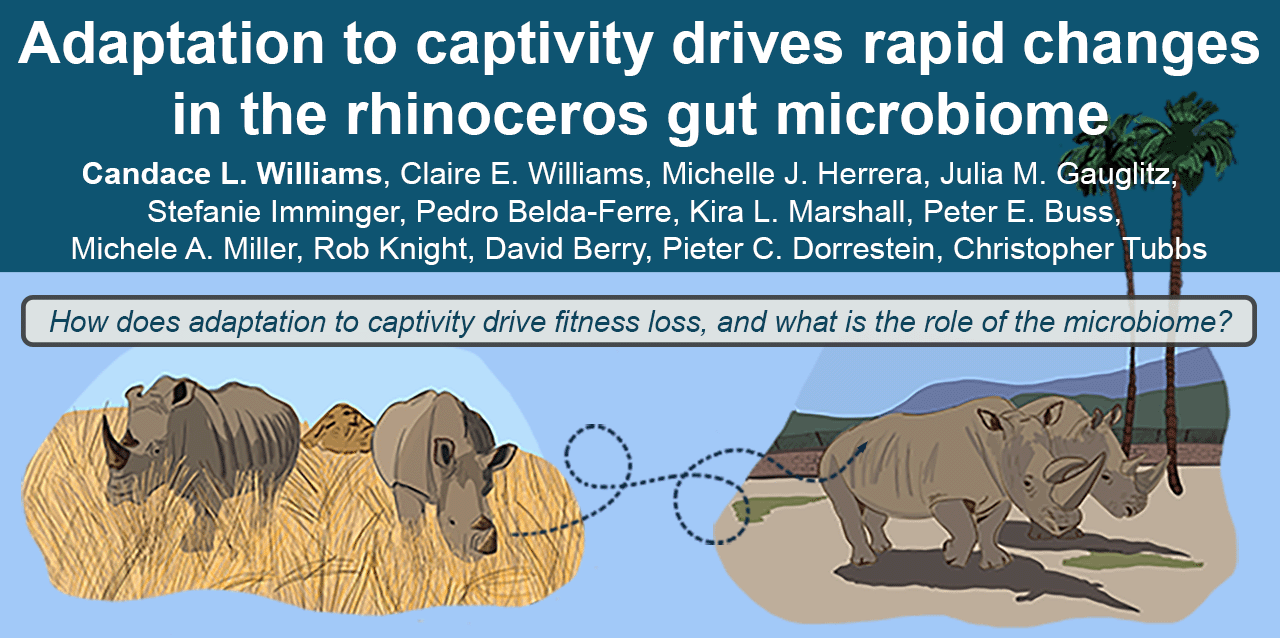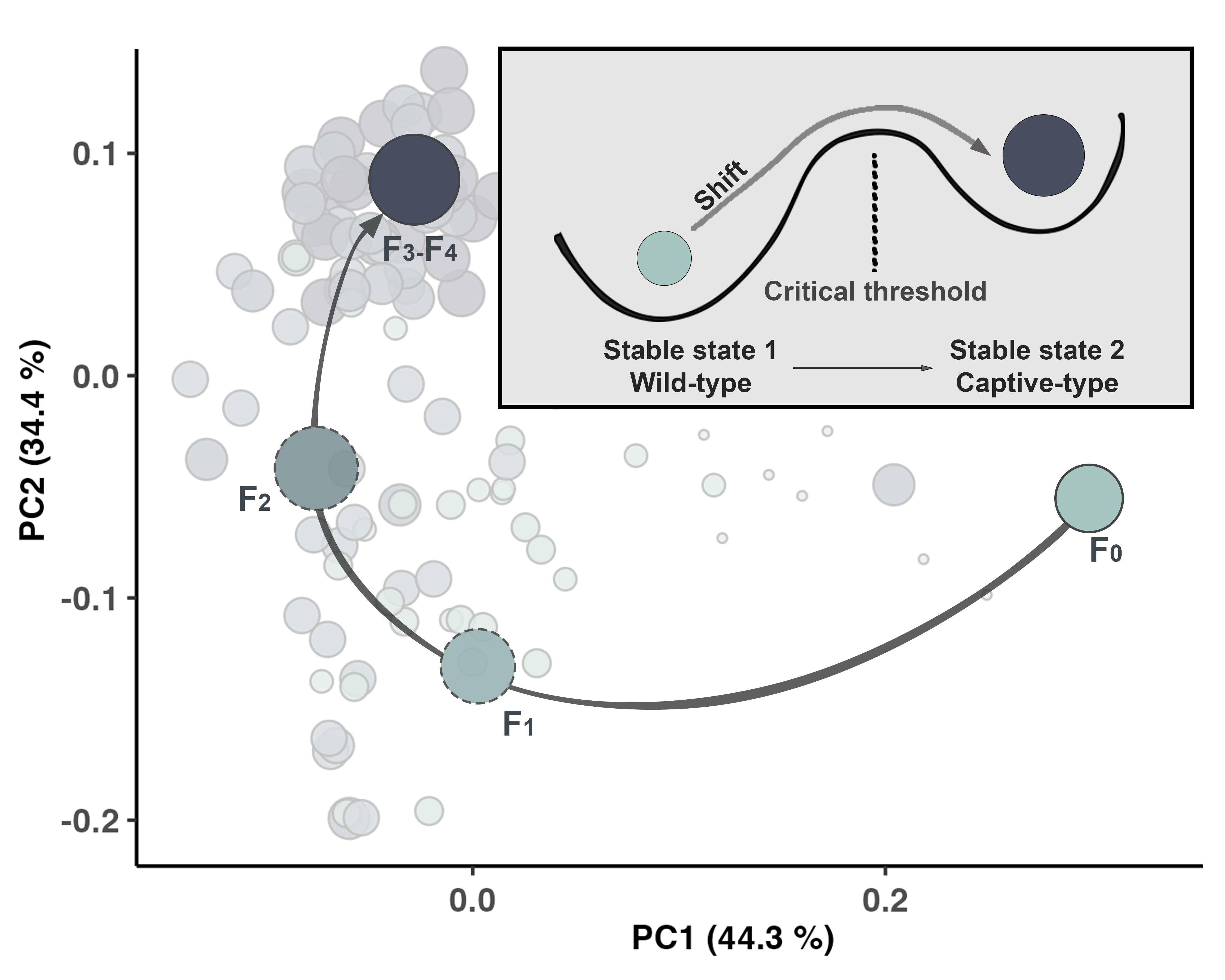How do changing environmental factors shift microbiota to alter animal fitness?
Diet and seasonality shape gut microbiome dynamics
Many factors can shape the gut microbiome, including diet. My work on giant and red pandas has characterized how changing dietary preferences relate to shifting microbial communities in pandas [1], and how they may subsequently lead to gastrointestinal disease in captivity [2]. In red pandas, we have characterized the development of a healthy microbiome in cubs through adulthood [3], as well as how season may also relate to changing microbiota [4]. Building from this work, we have also expanded beyond pandas to better understand how how seasonal shifts affect stability and gut microbiome dynamics across the tree of life [4,5]. In our recent paper, we highlight how the differences in microbiome richness and network connectivity between different animal species may affect the level of temporal stability in the gut microbiota across the year [4].
Transition in and out of captivity is linked to multi-generational shifts in the microbiome that mirror animal health and fitness metrics
While long-term effects of captivity are observed for a number of animals, the transition between in and ex situ and subsequent impacts on fitness are not well understood. In southern white rhinos, we found that microbial extirpation and replacement occurs rapidly after animals enter captivity and alters microbiome activity, as observed through sequencing, targeted and untargeted metabolomics and Raman microspectroscopy [6]. See our poster at ISME18 here.

In Pacific pocket mice, we characterized how mice and their microbiomes respond to the environmental pressures of captivity across five generations, finding the microbiome assumes a novel, stable conformation after two to three generations in captivity, and that the flux observed in microbial communities mirrors the flux of mouse weight and reproductive metrics [7]. This question also extends beyond the gut system, where our work in mountain yellow-legged frogs also explores how microbiota may be critical for their recovery after reintroduction to the wild. Overall, I aim to understand how the loss of critical keystone microbes as animals adapt to novel conditions and how short-term changes in microbiota and subsequent functional shifts may be used to predict or improve long-term animal fitness.

Other related work
- Understanding how the gut microbiome of a tropical ectotherm responds to thermal stress, in collaboration with Claire Williams and Mike Logan (Uni. of Nevada, Reno).
- A moving target: movement ecology reimagined, in collaboration with Mrinalini Erkenswick Watsa (SDZWA), Stefan Prost (Uni. of Oulu), Caroline Moore (SDZWA), Eben Broadbent (Uni. of Florida), Angelica Almeyda Zambrano (Uni. of Florida), and Gideon Erkenswick (Field Projects International).
References
- Williams CL, Willard S, Kouba A, Sparks D, Holmes W, Falcone J, Williams CH, Brown A (2012). Dietary shifts affect the gastrointestinal microflora of the giant panda (Ailuropoda melanoleuca). Journal of Animal Physiology and Animal Nutrition, 97: 577-585.
- Williams CL, Dill-McFarland KA, Vandewege M, Sparks DL, Kouba AJ, Willard ST, Suen G, Brown AE. (2016). Dietary shifts may trigger dysbiosis and mucous stools in giant pandas (Ailuropoda melanoleuca). Frontiers in Microbiology, 7:661.
- Williams CL, Dill-McFarland KA, Sparks DL, Kouba AJ, Willard ST, Suen G, Brown AE. (2018). Dietary changes during weaning shape the gut microbiota of red pandas (Ailurus fulgens). Conservation Physiology, 6(1) cox075.
- Williams CE, Brown AE, Williams CL (2023). The role of diet and host species in shaping the seasonal dynamics of the gut microbiome. accepted, FEMS Microbiology Ecology, fiad156, https://doi.org/10.1093/femsec/fiad156.
- Parascandola CE, Gautlitz JM, Tubbs CW, Dorrestein PC, Williams CL (2023) Seasonal changes in dietary phytoestrogens and their effect on the rhinoceros gut microbiome, in preparation.
- Williams CL, Williams CE, Imminger S, Gauglitz JM, Herrera MJ, Marshall KL, Belda-Ferre P, Buss P, Miller M, Knight R, Berry D, Dorrestein PC, Tubbs CW (2023) Captivity rapidly alters the rhinoceros gut microbiome and is linked to long-term fitness loss, in preparation.
- Williams CL†, Williams CE†, King SND, Shier D (2023) Environmental change is linked to multi-generational shifts in the gut microbiome that mirror animal health and fitness metrics, see preprint on bioRxiv 2023.10.24.563854; doi: https://doi.org/10.1101/2023.10.24.563854. †contributed equally.
